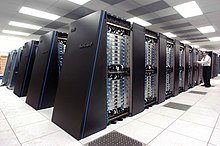List of computer size categories
This article needs additional citations for verification. (April 2024) |
This list of computer size categories attempts to list commonly used categories of computer by the physical size of the device and its chassis or case, in descending order of size. One generation's "supercomputer" is the next generation's "mainframe", and a "PDA" does not have the same set of functions as a "laptop", but the list still has value, as it provides a ranked categorization of devices. It also ranks some more obscure computer sizes. There are different sizes like minicomputers, microcomputers, mainframe computers and super computers.[1][2]
Large
[edit]
These are mainly used for scientific calculations or simulations and processing big data with high precission.[2]
Intermediate
[edit]Microcomputer
[edit]This is a very broad categorization that includes computers with a single microprocessor as their central processing unit (CPU).[2][6]
- Personal computer (PC) [1]
- Desktop computer—see computer form factor for some standardized sizes of desktop computers
- Home computer
Mobile
[edit]- Desktop replacement computer or desknote
- Laptop computer
- Notebook computer
- Subnotebook computer
- Tablet personal computer
- Handheld computers, which include the classes:
- Ultra-mobile personal computer, or UMPC
- Personal digital assistant or enterprise digital assistant, which include:
- Electronic organizer
- E-reader
- Pocket computer
- Calculator, which includes the class:
- Graphing calculator
- Scientific calculator
- Programmable calculator
- Accounting / Financial Calculator
- Handheld game console
- Portable media player
- Portable data terminal
- Handheld
- Smartphone, a class of mobile phone
- Feature phone
- Wearable computer
- Single-board computer
- Wireless sensor network components
- Plug computer
- Stick PC, a single-board computer in a small elongated casing resembling a stick
- Microcontroller
- Smartdust
- Nanocomputer
Others
[edit]- Rackmount computer
- Small form-factor PC (SFF, ITX, DTX.etc.)
See also
[edit]References
[edit]- ^ a b c d Warford, J. Stanley (November 2004). Computer Systems. Jones & Bartlett Learning. p. 11. ISBN 978-0-7637-3239-4.
- ^ a b c d II, Joseph D. Dumas (25 November 2016). Computer Architecture: Fundamentals and Principles of Computer Design, Second Edition. CRC Press. p. 35. ISBN 978-1-4987-7274-7.
- ^ "Mainframe | Definition & Facts | Britannica". www.britannica.com. 8 March 2024.
- ^ "Supercomputer | Definition, Characteristics, Examples, & Facts | Britannica". www.britannica.com. 8 April 2024.
- ^ Connolly, James (September 30, 1985). "Superminis: Dynamic machines evolving to new uses". Computerworld. p. SR/4, SR10. Retrieved 5 December 2019.
No one can say with certainty who coined the word 'superminicomputer' and to what systems he meant it to apply, but consensus is emerging that a supermini is nothing more than a minicomputer — a high-end mini, but a mini nonetheless.
- ^ "Microcomputer | Definition, Examples, Uses, & Facts | Britannica". www.britannica.com. 19 March 2024.
